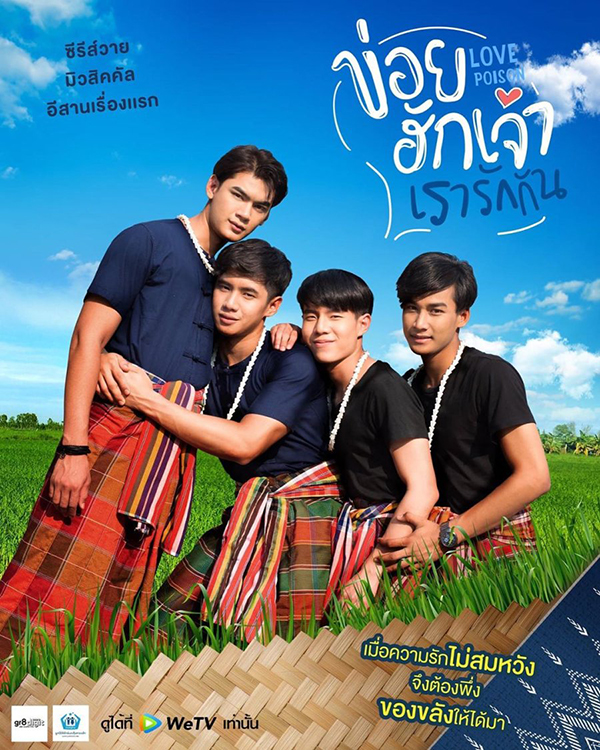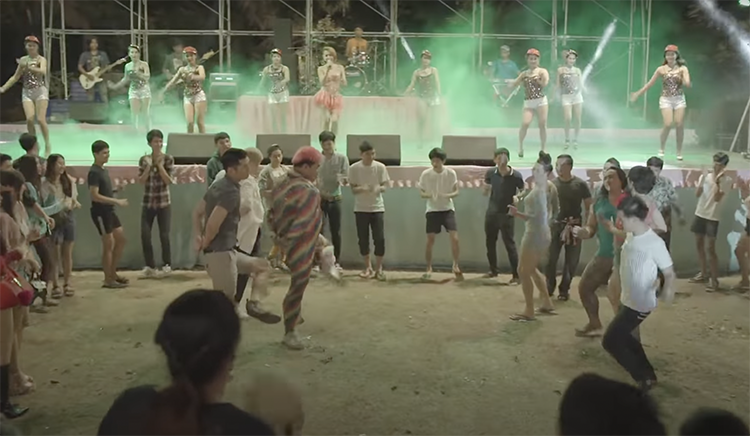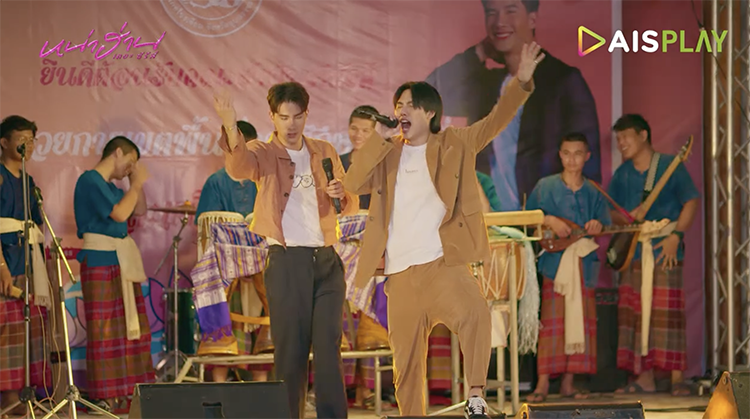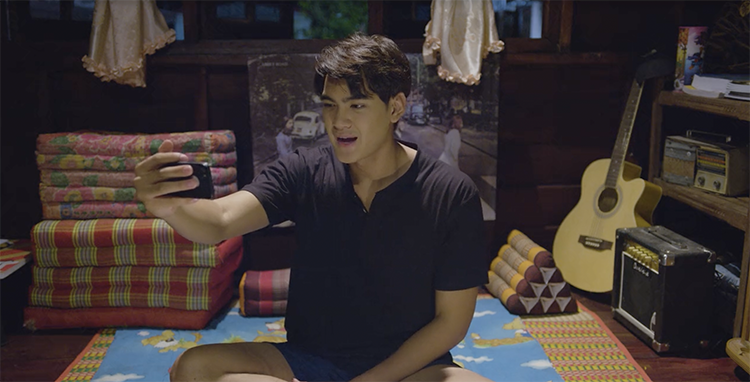|
Intersections: Gender and Sexuality in Asia and the Pacific
Issue 49, June 2023 doi: https://doi.org/10.25911/4RDP-2419 |
|
Queer Desire and the Aesthetics of Rural Cosmopolitanism Chairat Polmuk The global success of Japanese male homoerotic media known as Boys Love (hereafter BL) can be partly explained by the malleability of its generic conventions that allow for localised forms of sexual fantasy and identification in a particular context. As Kristine Michelle Santos has noted, the transnational flows of BL media rely on an expansion of the fundamental generic convention or ōdō (noble road, a metaphor for a grand narrative pattern) that centres on the seme-uke romantic relationship, a multimodal practice that involves 'technical, textual and visual literacies that contribute to a database of various narrative trope (neta), characters (kyara) elements, relationship dynamics (kankeisei), and moe (affect-evoking) elements in Japanese media.'[1] In Thailand, where yaoi fiction (niyai wai) and yaoi series (series wai) have commercially flourished since the 2010s, this new genre of male youth intimacy has undergone a complex process of 'glocalistion' through the adoption of pre-existing styles and narrative tropes from popular heterosexual mediascapes.[2] In his recent research on Thai yaoi novels, Natthanai Prasannam, a leading BL scholar in Thailand, charts localised subgenres in which contemporary Thai authors couple the Japanese BL tradition with stylistic repertoires of heterosexual romance—historical, paranormal, military—more familiar to Thai audiences.[3] Through the lens of queer analysis, Prasannam illustrates how literary adaptations transform queer desire as available for critical interventions into a national public previously dominated by heterosexual culture. In this paper, I discuss a small yet significant instance of BL adaptations in Thailand in which a vernacularised genre of homoeroticism is extended beyond metropolitan Bangkok to provincial areas. This includes a BL series titled Love Poison (Khoi Hak Chao, Rao Rak Kan, dir. Phadej Onlahung, 2019) and a heterosexual teen romance featuring a BL-style couple (khu wai) titled Nha Harn, The Series (dir. Chantana Tiprachart, 2022). Both are set against the backdrop of Thailand's countryside in the Lao-speaking, northeastern region known as Isan with heavy references to both stereotypical and self-reflexive representations of Isan culture. Advertised as 'the first Isan musical BL series,' the poster of Love Poison features an intimate group shot of the main characters clad in traditional Isan sarongs and loincloths (pha khaw ma) in the middle of a rice field (Figure 1). The title of Nha Harn refers to the lower front of the stage of traditional Lao–Isan performance known as mor lam where audiences dance (Figure 2). Central to both series is thus the drama of high school teenagers, whose romantic relationships are conspicuously framed by their regional cultural milieu. 
Figure 1. Love Poison's poster features the show's main protagonists in traditional Isan sarongs and loincloths. Source. MyDramaList, 'Love Poison (2019),' accessed 10 Feb. 2023. 
Figure 2. 'A group of main characters dancing in front of the stage of traditional Isan mor lam performance,' Chantana Tiprachart, Nha Harn, The Series, 2022. Source. Nha Harn, The Series Official Trailer, 1 Feb. 2022, accessed 10 Feb. 2023. As an ethnically marked region that was gradually, often violently, assimilated into the Thai nation-state in the early twentieth century, Isan as featured in these series inevitably engages with a long history of marginalisation, urban–rural divides, and regionalism.[4] In bringing queerness to bear on such political issues, this emerging subgenre of rural BL invites us to consider a serious question regarding the relationship between sexual politics and the politics of ethnic representation. On the one hand, the BL appropriation of heterosexual pastoral romance risks perpetuating exoticised images of Isan at the service of queer sexual fantasy. On the other hand, queerness can be mobilised to address both the problematics of sexual and regional minoritisation. In what follows, I examine this tension in Love Poison and Nha Harn through the lens of rural cosmopolitanism that denotes both the changing sociopolitical landscape and a new aesthetic sensibility of the region. By invoking the oxymoron of rural cosmopolitanism, my essay engages with the postcolonial critique of the universalist conception of globalisation. In his preface to the 2004 edition of The Location of Culture, titled 'Looking Back, Moving Forward: Notes on Vernacular Cosmopolitanism,' Homi K. Bhabha suggests that 'a just measure of global progress requires that we first evaluate how globalizing nations deal with "the difference within"—the problems of diversity and redistribution at the local level, and the rights and representations of minorities in the regional domain.'[5] In the context of contemporary Thailand, the question of 'difference within' has been raised by scholars in Thai studies who have sought to understand the effects of globalisation on economic and political aspirations of Isan villagers. As I focus on Isan BL media as an encounter between the rural and the cosmopolitan, understood here in its colloquial connotations as global urban culture, the framework of rural cosmopolitanism allows me to consider 'how members of rural communities imagine their affiliations to the globe and how their location in rural places shapes their framing of cosmopolitan ethical and political responsibility.'[6] Taking into account the potential of BL as a 'sociopolitical force in the world,' as James Welker puts it, I first locate both series' cosmopolitan aspects of ethical and political responsibility within the context of contemporary Thai politics.[7] Revigorated regionalism and Thai Ban aesthetics The opening scene of Love Poison shows one of its main characters, Ko, cheerfully singing and dancing to an upbeat country song (phleng lukthung) in a rice field while his brother, Sek, is filming. Ko, as viewers will later learn, is a YouTuber locally well-known for his musical talent. Despite an unmistakably idealised depiction of pastoral life, the scene captures the changing landscape of today's Isan village in which the dividing line between the rural and the urban is blurred. In Nha Harn, The Series a group of Isan teens is shown discussing a new video from the Korean boy band BTS (Bangtan Boys) and mimicking a K-drama dialogue. This juxtaposition between the local and the cosmopolitan often produces laughter, but it also implies a sense of parodic reflexivity, a self-mockery that destabilises a romantic portrait of Isan as uncorrupted by modernity.[8] Figured in both series is thus a regionalist sentiment that incorporates elements of cosmopolitanism, including the BL queer culture itself. Political and cultural historians have identified socioeconomic changes since the end of the Cold War and the more recent political struggle as key factors to this emergent cosmopolitan outlook of Isan.[9] Particularly, the uprising of Red Shirt protestors, most of whom were from provincial areas, following the military overthrow of the former prime minister Thaksin Shinawatra in 2006, encouraged scholars in Thai studies to revisit the notions of political subjectivity and national belonging in Isan. For example, Mary Beth Mills maps divergent patterns of domestic and transnational migrations of Isan residents in the context of political turmoil to argue that 'experiences of mobility represent both physical and symbolic counterclaims to dominant images of rural backwardness and ignorance with clear potential to undermine hierarchical discourses of cultural citizenship.'10 Another anthropologist, Charles Keyes, who wrote on Isan regionalism long before the uprising, examines the same political movement and posits that 'the dramatic climax of the confrontation between the Red Shirt demonstrators and government forces was not the end of the story. On the contrary, it is but the latest episode in a much longer saga about the transformation of semi-traditional peasant villagers into modern cosmopolitan "villagers."'[11] In the domain of aesthetic expression, this reformulated idea of Isan regionalism has resulted in literary, art, film and media production that centres on Isan or deliberately eschews Bangkok as a political and cultural frame of reference.[12] The quasi-pejorative term, 'Thai ban,' which can be translated as 'country-folk,' has been a recurrent self-designation for Isan filmmakers and cultural producers. Thai Ban, The Series (originally spelled Thi Baan), a five-instalment comedy film series (2017–2021), is famous among viewers in Isan and Lao PDR for its non-traditional portrayals of contemporary lives in the region.[13] Phu Bao Thai Ban E-San Indy, another film franchise (2014–2021) that recounts stories of young country men (phu bao) in Isan, is another example that reflects the cultural and aesthetic currency of the Thai ban label. In an interview, Uthen Sririwi, the director of all four instalments of the Phu Bao Thai Ban franchise, remarks that he wants his film to be 'mass [read mainstream] but indie' at the same time. He also cites Apichatpong Weerasethakul, a Thai auteur with an Isan background whose films often interrogate the region's violent past, as his inspiration for 'indie' or arthouse filmmaking.[14] More strikingly, there also emerged a comic subgenre of kathoey Thai ban—effeminate/transgender country folks—starting with a low-budget production by Mahasarakham University students, Kathoey Thai Ban (2013). While these filmmakers use the term Thai ban with different degrees of criticality, they share a regionalist sentiment by transforming regional cultural stigma into pride in their depictions of quotidian lives and sexualities in contemporary Isan, eschewing nationalist discourses. In outlining this emergence of Isan regionalism, I have no wish to reinforce the distinction between the rural and the urban and between Isan and Bangkok. Rather, I offer a sketch of the current situation in which such distinctions are questioned, becoming the ground for cultural contestations and negotiations among social actors, including BL media producers. Bringing recent scholarship in Isan regionalism into conversation with BL studies, I argue that the configurations of queer desire in the 'Thai ban' BL media under review further complicate the urban–rural dichotomy by illuminating the cosmopolitan dimension of the region's self-imagining. As culturally imported BL media is provincialised through Thai ban aesthetics, the BL-induced queer desire is in turn mobilised to challenge predominantly Bangkok-centric views of Isan. Acknowledging BL's problematic representations of homosexuality and its damaging effects on LGBT communities, scholars in BL studies have suggested that BL potentially affords a rethinking of gender and sexuality.[15] Through the concept of queer counterpublic, Andrea Wood contends that 'boy-love manga are not simply queer because they depict homoerotic love stories between men, but rather because they ultimately reject any kind of monolithic understanding of gendered or sexual identity.'[16] I expand this scholarly attention to queerness as a non–identitarian approach to regional identity. How might rural cosmopolitanism be differently articulated when the region is queered through the BL subgenre? Queer intimacy at the periphery Love Poison and Nha Harn follow the Japanese and Thai BL convention in their themes of high school romance. However, in taking this romance to the countryside, both series display several features distinct from conventional depictions of high school dramas. First, the rural setting plays as significant role—physically and symbolically—as the school. In fact, both series thematise conflicts between their characters' rural lifestyles and school lives. In Love Poison, the theme song humorously narrates the frustration of a provincial high school boy (phu bao nakrian) who must choose between studying and joining a music truck (rot hae) parade. The ending scene shows the two young male couples dancing in front of the music truck, denoting simultaneously their romantic and cultural fulfillment. In Nha Harn, criticism of the school and the educational system is central to the series' narrative of hetero- and homosexual teen drama along the Mekong River that divides Thailand and Laos. Film critic Wiwat Lertwiwatwongsa posits that Non Hin Hae School in the series is an allegory of the country's authoritarian regime, as the series makes explicit references to state violence against the rural Red Shirts.[17] Lertwiwatwongsa also links the depiction of rebellious students in Nha Harn to more recent pro-democracy student protests such as those organised by the 'Bad Student' group.[18] In diverging from the typical metropolitan setting of Bangkok-based BL, these series make queer desire available for a reformulation of Isan regionalism. 
Figure 3. 'Rural setting and homoerotic desire,' Phadej Onlahung, Love Poison, 2019. Source. Khoi Hak Chao, Rao Rak Kan EP.3 [Love poison EP.3], 20 Nov. 2019, accessed 15 Feb. 2023. Countryside settings are vital to expressions of homoerotic desire in Love Poison and Nha Harn. At one level, elements of agrarian life reinforce a kind of traditional masculinity that potentially attracts BL viewers. In Love Poison, a courting scene between Sek and Tak takes place in a rice field where the two young men are catching fish (Figure 3). The following scene depicts the half-naked Sek and Tak cooking near a straw hut and tasting their fish curry in the most sensual way possible. Traditional masculinity is also highlighted in Nha Harn, in which BL characters, the closeted gay man Tlemai (pronounced 'tern-mai') and the straight Kay, often leisurely practice Sepak Takraw, regarded as a highly traditional and masculinist sport. In a climactic scene in which they finally kiss, a majestic vista of the Mekong River serves as a background for their symbolic consummation (Figure 4). 
Figure 4. 'Romance at the Thai–Lao border,' Chantana Tiprachart, Nha Harn, The Series, 2022. Source. Nha Harn, The Series EP. 6 Part 3/4,' 29 Mar. 2022, accessed 15 Feb. 2023. Bordering on exoticisation of the countryside, the two series nonetheless offer refreshing perspectives on queerness and rurality. In his review of Nha Harn, Wiwat Lertwiwatwongsa compares the series' depiction of queer intimacy between Tlemai and Kay to that of Apichatpong Weerasethakul's experimental queer film Tropical Malady (Sat Pralat, 2004) that also depicts male homoerotic relations in the countryside. Weerasethakul's utopian vision of a permissible queer intimacy in Tropical Malady, he argues, becomes completely normalised twenty years later through the BL-themed series.[19] Through the notion of casualness and ordinariness, Arnika Fuhrmann contends that Weerasethakul's attentiveness to ordinary provincial lives 'opens the view onto the counter normative possibilities of a pervasive, quotidian homoeroticism in contemporary Thailand.'[20] Along these lines, I would further propose that in rendering homoeroticism pervasive and ordinary, these BL series queer the rural landscape. In other words, they transform a rural space traditionally associated with hypermasculinity and heterosexuality into an ordinary scene of nonnormative sexuality and fantasy.[21] The notion of queer ordinariness does not suggest that homosexuality presented in the series is void of social or psychological conflicts. Love Poison, in its idealised depiction of Isan as a space of social acceptance, features a scene in which Ko and Sek's father verbally comforts the spirit of his deceased wife about the sexuality of their sons. Interestingly, the father is played by Monsit Khamsoi, a famous Isan folk singer who came out as gay in his fifties and faced some homophobic reactions. He later admitted that he had a wife and a daughter but remained ambiguous about his own sexuality. This extradiegetic reference, not unfamiliar to Thai audiences, added another layer to the series' representation of nonnormative sexuality in which the father figure is rendered as queer or bisexual. Social conflicts are also highlighted in Nha Harn, where an absence of the father figure is problematised. In one flashback, the young Tlemai is playing house with his female friend, Calcium or Khaew. Due to his lack of a father, Tlemai is clueless about how to play the role of a father, deciding to take off his clothes in imitation of male guests who frequent his mother's love motel. Sharing the same lack, Calcium is told that her father has been away working as a migrant labourer in South Korea. The absence of the father figure thus explains their intimate relationship, which, in their teenage years, leads them to pretend to be together to cover up Tlemai's sexuality. As Tlemai gradually develops a romantic relationship with Calcium's younger brother, Kay, a love triangle forms. The series resolves this tension subtly by translating this all-too-familiar trope to a kind of queer kinship between these characters searching for family ties. In his essay on Thai yaoi novels by Ro Ruea Nai Mahasamut, Natthanai Prasannam relates the problematic portrayal of the father figure to a queer critique of patriarchy. Figured as either absent or dead, the spectral presence of the father in these texts signifies looming patriarchal power with which yaoi protagonists struggle as they explore their sexualities and gender roles.[22] This applies to Tlemai's situation in Nha Harn, in which the absence of the father figure can be read as a haunting effect of heteronormativity. However, as Calcium's father is also absent, we might further expand the significance of this motif in imagining the possibilities of queer kinship, understood here as a non-normative form of intimacy and belonging. The absence of the father figure creates a wound for both of them, but it is not simply devised to induce trauma. Rather, it is through the mutual recognition of the other's lack and vulnerability that these characters develop a profound relationship beyond a heteronormative understanding of family and coupledom. The queer politics of sexuality in Love Poison and Nha Harn not only involve taking over a social space of patriarchy and heterosexuality but also incorporating culturally specific Isan queer practices into their configurations of quotidian homoeroticism. As mentioned earlier, both series draw heavily upon Isan cultural practices such as country music (phleng lukthung), music truck (rot hae), and mor lam music to convey Thai ban aesthetics. These practices are not inherently queer but have been historically linked to queer subculture and sexuality. In his ethnographic study of an open–air mor lam space or nha harn in Northeast Thailand, Pornthep Phraekhao scrupulously details how this mor lam performance provides a space for male-to-female transgender people or kathoeys to express their sexuality and seek potential sexual partners.[23] The nha harn riotous dance as a queer subcultural practice has recently been popularised in mainstream media. An episode of a popular Thai queer comedy, Diary of Tootsie (2016–18), for example, includes a dance battle between urbanised queer characters and rural Isan kathoeys at a mor lam concert (Figure 5). While the team of queer Bangkokians flaunts their urbanised identity by opting for a Korean-style dance, the rural trans people are comically shown as wild and unruly. The episode is indeed a satire about an Isan woman who fails at covering up her Isan origins through her poor imitation of an English-speaking, overseas student. In other words, queer folk culture in mainstream media can be deployed to reinforce a cultural hierarchy between the urban/cosmopolitan and the rural. 
Figure 5. 'Mor lam performance as a queer space,' Kittiphak Thongauam and Pat Boonnitipat, Diary of Tootsie, 2016. Source. 'Diary of Tootsie EP. 12 Part 1/4,' 10 May 2016, accessed 25 Feb. 2023. Nha Harn, itself an expanded version of the 2019 film by the same name, explicitly borrows the queer subculture of mor lam as its central setting and plot device. However, unlike the comic appropriations of Isan cultural practices in mainstream media such as Diary of Tootsie, the series deploys folk culture in a more critical way. Rather than staging a binary opposition between the rural and the cosmopolitan, the energetic and often lascivious nha harn dance is portrayed as a form of resistance to sexual restriction and despotism in school. In a scene in which a school headmaster tries to impress the authorities with student performances, the main female character Yupin interrupts the show by taking off her school uniform and performing a riotuous nha harn dance in front of the stage, an activity that ends in total chaos. Throughout the series, Yupin embodies non-traditional femininity along with her queer companions and other recalcitrant female friends who share the same passion for nha harn dance. While focusing on a heterosexual love triangle between Yupin, Sawan and Singtho, the series foregrounds queer folk culture and realises its potential to disrupt conventional sexual representations and to challenge asymmetrical power relations. Through an adaptation of BL conventions, Love Poison and Nha Harn thus present a vernacular subgenre in which queer intimacy is ingrained in the texture of ordinary life in rural Isan. In the context of reinvigorated regionalism, the quotidian politics of queerness offer new frameworks for decentralising Bangkok-dominated (mis)conceptions of the region. The rural landscape of Isan becomes a site of political resistance in which non-normative desire is one of its defining features. Provincialised BL and rural cosmopolitanism Love Poison and Nha Harn portray rural life in Isan as exuberant and dynamic, with queer culture at the centre of such economic and sociocultural vibrancy. Queerness serves as a locus of transnational exchange of cultural and economic capital. The emergence of vernacularised Thai ban BL itself can be understood as an instance of this cosmopolitan influx that allows for more nuanced articulation of Isan cultural citizenship. Here I follow Mary Beth Mills in using the term 'cultural citizenship' after Aihwa Ong's definition: 'Cultural citizenship is a dual process of self-making and being-made within webs of power … shifting fields of power that include the nation-state and the wider world.'[24] The negotiation with 'the wider world,' as we shall see, involves a reflexive appropriation of BL in the process of cosmopolitan self-imagining. In Nha Harn, one of the most memorable sequences is when the school principal invites internationally known Thai BL stars Max (Nattapol Diloknawarit) and Tul (Pakorn Thanasrivanitchai) to attend a school event. As a self-parodic reference to BL appropriation, the sequence is significant in multiple ways. First, the presence of Max and Tul frames a homoerotic relationship between Tlemai and Kay, who greet the arrival of the BL superstars with a sense of distance. In the following scene, Kay finds out that his girlfriend, Toey, has had an affair with his close friend, leading to their breakup. Kay subsequently seeks comfort in Tlemai, who has been helping him deal with Toey's capricious behaviour. The series thus deploys a conventional trope of the doomed heterosexual relationship to highlight a kind of love-knows-no-gender romance between the BL couple. With an extratextual reference to another BL series, it does so with a sense of mockery and humour. Second, the presence of Max and Tul evokes ethnocultural differences between Bangkok-based celebrities and rural folks but to a surprising end. As the school principal tries to impress Bangkokian authorities and superstars with a modernised pong lang performance led by his own daughter, the presence of Max and Tul underwrites his aspiration for being modern and cosmopolitan. Following Yupin's interruption of the show with her nha harn dance, however, we see Max and Tul cheerfully joining her in a mor lam-style concert (Figure 6). This unexpected turn of events realigns the cosmopolitan with the rural, asserting that they coexist in contemporary Isan, especially through BL-derived queer culture. 
Figure 6. 'Thai BL superstars joining mor lam-style concert,' Chantana Tiprachart, Nha Harn, The Series, 2022. Source. Nha Harn, The Series EP. 5 Part 2/4' 21 Mar. 2022, accessed 6 Mar. 2023. Another instance that marks Nha Harn's deliberate and playful engagement with BL culture is that the series features several BL actors from previous well-known series. Tlemai, for example, is played by Thanatsaran Samthonglai, who has appeared in GMM-produced BL series such as Blacklist (Blacklist—Nakrian Lap Banchi Dam, 2019) and 2gether: The Series (Phro Rao Khu Kan, 2020). Dechphisit Jarukornapiwat, who plays Sawan, and Ratchapat Worrasarn, who plays Singto, have also made appearances in BL series. In this light, Nha Harn consciously participates in the broader BL cultural practice of khu jin (imagined couples) in which co-actors in BL media are projected to be real couples.[25] In the less critical Love Poison, queerness is also positioned alongside rural cosmopolitanism. At the beginning of the series, the love-stricken Ko seeks a love potion from a village shaman with the hope that it will make Teng, a straight soccer player, fall in love with him. It turns out that Teng is from the beginning interested in Ko's musical talent and Internet personality. They gradually develop an intimate relationship as Ko becomes a private tutor for Teng's singing lessons. Thus, while the title of the series stereotypically associates Isan with supernaturalism, this allusion plays little role in framing the series' dramatisation of rural queer intimacy. Rather, it is a mixture of elements of rural and cosmopolitan culture that furnishes a configuration of quotidian homoeroticism. When Teng realises his mutual feelings for Ko, he becomes an Internet personality himself, singing a country song on Facebook Live to express his love for Ko (Figure 7). The conflict staged here is therefore not between the rural and the urban, but between the stereotypically backward rural and the more dynamic portrait of rural life. 
Figure 7. 'Teng singing a country song on Facebook Live,' Phadej Onlahung, Love Poison, 2019. Source. Khoi Hak Chao, Rao Rak Kan EP. 7' [Love Poison EP.7], 23 Oct. 2019, accessed 10 Mar. 2023. The imbrication—rather than opposition—between the rural and the cosmopolitan distinguishes representations of Isan in these series with those of previous films and other popular media. In his essay on the construction of Isan identity in romantic comedy films in the aftermath of the 1997 Asian economic crisis, Natthanai Prasannam points out that portrayals of the northeastern region in films such as Hak Na Sarakham (dir. Tanwarin Sukkhapisit, 2011) and White Buffalo (dir. Chinores Kamwandee, 2011) are essentially imbued with nostalgia for Bangkok's pastoral Other. These films often dramatise an encounter between Iocal practices and westernised cultural imports only to stress the importance of Isan cultural roots.[26] In Love Poison and Nha Harn, Isan cultural values remain central to their narratives, but the hostility toward foreign influences becomes significantly diluted. What is more, Isan cultural practices figured in these BL-themed series exceeds rigid perceptions of Isan in the 1990s, which were largely governed by academic and NGO discourses of folk wisdom (phum panya chaoban).[27] Within this restricted framework of local cultural heritage, the queer subcultural practice of riotous nha harn dance, for example, is generally viewed as lewd and indecent. In contemporary BL media, however, this folk culture informs an articulation of cultural citizenship that does not conform to nationalist discourses of social belonging. Coda In locating Love Poison and Nha Harn within the wider context of reinvigorated regionalism in Northeast Thailand or Isan, this paper has delineated what this emergence of the BL-subgenre tells us about the intersection between the politics of queer desire and the cultural as well as affective politics of Isan regionalism. What stands out in this account of a strange encounter between the globally circulated genre of BL and an Isan folk aesthetic idiom of Thai ban is the mobilisation of queer desire to reimagine multiple ways of being an Isan citizen in the contemporary world. In both series, BL-derived queerness affords an expression of resistance against sexual restrictions, ethnic stigamatisation, and political oppression, especially with regard to Bangkok–centric perspectives and nationalist discourses. Narratives of quotidian homoeroticism also involve reconfigurations of kinship and sociality in rural areas that exceed normative understandings of intimacy. Ultimately, this paper offers not a mere recuperative reading of BL but an analysis of the vernacularisation of the genre in a culturally specific context. The series I have examined here vary in their degree of self-reflexivity and political awareness, but both of them help expand the existing framework on the problematics of the urban-rural divide by bringing the notion of queer desire to bear on this scholarly debate. Notes [1] Kristine Michelle Santos, 'Glocalization of Boys Love Dōjinshi in the Philippines, Malaysia, and Australia,' in Queer Transfigurations: Boys Love Media in Asia, ed. James Welker, 227–42 (Honolulu, HI: University of Hawaiʻi Press, 2022), pp. 228–29. [2] Thomas Baudinette, 'Lovesick, The Series: Adapting Japanese "Boys Love" to Thailand and the Creation of a New Genre of Queer Media,' South East Asia Research 27(2) (2019): 115–32, doi: 10.1080/0967828X.2019.1627762. See also Natthanai Prasannam, 'The yaoi phenomenon in Thailand and fan/industry interaction,' Plaridel: A Philippine Journal of Communication, Media, and Society 16(2) (2019): 62–89, doi: 10.52518/2020.16.2-03prsnam . [3] Natthanai Prasannam, Nawaniyai yaoi khong Thai: kanmuang khong phetsathana lae phetwithi nai romance prachaniyom [Thai yaoi novels: The cultural politics of gender and sexuality in popular romance] (Bangkok: Research and Innovation Unit, Faculty of Humanities, Kasetsart University, 2021), especially Chapters Three and Five. In Chapter Three, Prasannam discusses the genre of reincarnation romance through LazySheep's novel, Dai Daeng (The red thread), which was adapted for a series, Until We Meet Again in 2019. In Chapter Five, Prasannam examines Bacteria's Nithan phan dao (A tale of one thousand stars) as military romance. [4] See, for example, David Streckfuss, 'An "ethnic" reading of "Thai" History in the twilight of the century-old official 'Thai' national model,' South East Asia Research 20(3) (2012): 305–27, doi: 10.5367/sear.2012.0115; Akiko Iijima, 'The Invention of "Isan" History,' Journal of the Siam Society 106 (2018): 171–200. [5] Homi K. Bhabha, 'Looking Back, moving forward: Notes on vernacular cosmopolitanism,' The Location of Culture (London: Routledge, 2004), p. 18. [6] Emily Johansen, 'Imagining the global and the rural: Rural cosmopolitanism in Sharon Butala's The Garden of Eden and Amitav Ghosh's The Hungry Tide,' Postcolonial Text 4(3) (2008): 1–18 [7] James Welker, 'Introduction: Boys Love (BL) Media and Its Asian Transfigurations,' in Queer Transfigurations: Boys Love Media in Asia, ed. James Welker, pp. 1–16. (Honolulu, HI: University of Hawaiʻi Press, 2022), pp. 10–12. [8] Pattana Kitiarsa identifies parody as an aesthetic feature of contemporary films on Isan migrants. See Pattana Kitiarsa, 'Nostalgic parodies and migrant ironies in two Thai comedy films,' in Films in Contemporary Southeast Asia, ed. David Lim and Hiroyuki Yamamoto, 203–18. (New York: Routledge, 2012), doi: 10.4324/9780203181904-12. [9] Charles Keys, 'Cosmopolitan' villagers and populist democracy in Thailand,' South East Asia Research 23(3) (2012): 343–60, doi: 10.5367/sear.2012.0109. [10] Mary Beth Mills, 'Thai mobilities and cultural citizenship,' Critical Asian Studies 44(1) (2012): 85–112, doi: 10.1080/14672715.2012.644888. [11] Keys, 'Cosmopolitan Villagers,'p. 345. See also Charles Keys, Isan: Regionalism in Northeastern Thailand (Ithaca: Cornell Southeast Asia Program, 1967), pp. 36–62. [12] For a discussion on Isan literary and media movement, see Jinwara Chuaychote, 'Kanplianplaeng khwamkit thang kanmuang nai wannakam khong nakkhian Isan rawang thotsawat 2530–2550' [Changing of political thoughts in literary works by Isan writers between the 1990s – 2000s]. MA thesis, Chiang Mai University, 2021. [13] Damrong Tumthong, 'Phapphayon Thai ban the series waduay watthanatham tortan phan wairun Isan runmai' [Thai Baan the series: expression of counterculture by Isan's new generation], Journal of Social Research 41(1) (2018): 147–87. [14] Suthida Ounchit and Uthen Sririwi, 'Uthen Sririwi khon Khon Kaen thi tham nang "Phu Bao Thai Ban" hai khon Isan du laew khithot ban lai–lai' [Uthen Sririwi: A filmmaker from Khon Kaen who produced "Phu Bao Thai Ban" that brought homesickness to Isan viewers], 18 Mar. 2020, accessed 20 Jun. 2022. [15] For an overview of the yaoi debate (yaoi ronsō) in Japan that emerged in the 1990s, see Ishida Hitoshi, 'Representational appropriation and the autonomy of desire in yaoi/BL,' in Boys' Love Manga and Beyond: History, Culture, and Community in Japan, trans. Katsuhiko Suganuma, ed. Mark McLelland, Kazumi Nagaike, Katsuhiko Suganuma and James Welker, 210–32 (Jackson, Mississippi: University Press of Mississippi, 2015), doi: 10.14325/mississippi/9781628461190.003.0011. Hitoshi identifies the discrimination against gay men and the projection of women's fantasies onto gay men as central concerns among critics. For a discussion of BL's problematic issues such as homophobia, misogyny, rape and other forms of violence, see Wim Lunsing, 'Yaoi Rons?: Discussing depictions of male homosexuality in Japanese girls' comics, gay comics and gay pornography,' Intersections: Gender, History and Culture in the Asian Context 12 (2006), accessed 27 Jan. 2023. [16] Andrea Wood, 'Straight women, queer texts: Boy-Love manga and the rise of a global counterpublic,' Women's Studies Quarterly 34(1–2) (2006): 394–414. [17] Wiwat Lertwiwatwongsa, 'Nha Harn, The Series: Mua kanten khue kantortarn lae nha harn khue phukhon' [Nha Harn, The Series: when dancing is a resistance, and the stage front are the people], The 101.World, 25 Apr. 2022, accessed 20 Jun. 2022. According to the series, the father of the female lead Yupin travels to Bangkok to join the Red Shirt demonstration and is later killed. [18] For a context of this student-led movement, see Punchada Sirivunnabood, 'Hope over fear: the 2020 student-led protests in Thailand,' ISEAS: Yusof Ishak Institute, 29 Oct. 2020, accessed 20 Jun. 2022. [19] Lertwiwatwongsa, 'Nha Harn.' [20] Arnika Fuhrmann, Ghostly Desires: Queer Sexuality and Vernacular Buddhism in Contemporary Thailand (Durham: Duke University Press, 2016), 131–32, doi: < ahref="https://doi.org/10.1515/9780822374251">10.1515/9780822374251. [21] In his analysis of a Thai popular military romance titled, Nithan Phan Dao (A tale of one thousand stars), Natthanai Prasannam proposes how we may understand this BL subgenre as homoeroticising hypermasculinist culture and institution of the military. See Natthanai Prasannam, 'Chai chat thahan kap chat nai nawaniyai yaoi ruang Nithan Phan Dao' [Military masculinity and nationhood in the yaoi novel A Tale of Thousand Stars], Journal of Human Sciences 22(1) (2021): 162–80. [22] Natthanai Prasannam, 'Phawakhwia nai nawaniyai yaoi khong Ro Ruea Nai Mahasamut' [Queerness in Ro Ruea Nai Mahasamut's yaoi novels]' Thammasat Journal 41(1) (2022): 137–60. In some of these novels, Prasannam notes the father figure is turned into an object of incestuous fantasy, another instance of queer subversion of patriarchy. [23] Pornthep Phraekhao, 'Phu sao nha harn mor lam khwamsamphan rawang kathoey lae phu chai in khonsoet mor lam Isan' [The sexuality of Isan Kathoeys in Mor Lam Spaces], in Phet lak chetsi: Phahuwatthanatham thang phet nai sangkhom Thai [Cultural pluralism and sex/gender diversity in Thailand], ed. Narupon Duangwises and Peter A. Jackson, 61–81 (Bangkok: Princess Maha Chakri Sirindhorn Anthropology Centre, 2013). [24] Aihwa Ong, 'Cultural citizenship and subject making: Immigrants negotiate racial and cultural boundaries in the United States,' Current Anthropology 37(5) (1996): 737–62, doi: 10.1086/204560. [25] See Kang-Nguyễn Byung'chu Dredge, 'Faen of Gay Faen: Realizing Boys Love in Thailand betwixt imagination and existence,' in Queer Transfigurations: Boys Love Media in Asia, ed. James Welker, 196–98 (Honolulu, HI: University of Hawaiʻi Press, 2022), doi: 10.1515/9780824892234-018. [26] Natthanai Prasannam, '"Isan" nai phapphayon Thai naew rak sukkhanattakham: attalak thi sang mai set? ["Isan" in Thai romantic comedy film: An unfinished construction of identity?],' in Niyai haeng niyam: ruang lao samai mai nai parithat kanmuang watthanatham [Storying the subject: Modern narratives from cultural politics perspectives], ed. Natthanai Prasannam, 253–77 (Bangkok: Department of Literature, Faculty of Humanities, Kasetsart University, 2013). [27] For a brief history of the concept, see Thongchai Winichakul, 'Coming to terms with the west: Intellectual strategies of bifurcation and post-westernism in Siam,' in The Ambiguous Allure of the West: Traces of the Colonial in Thailand, ed. Rachel V. Harrison and Peter A. Jackson, 135–52 (Hong Kong: Hong Kong University Press, 2010), doi: 10.5790/hongkong/9789622091214.003.0007. |

|